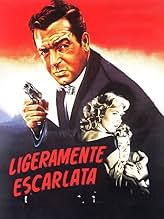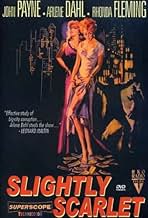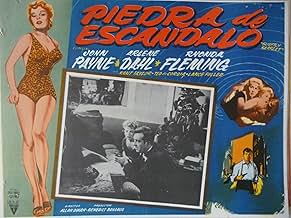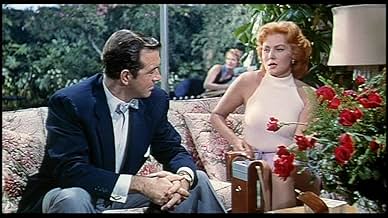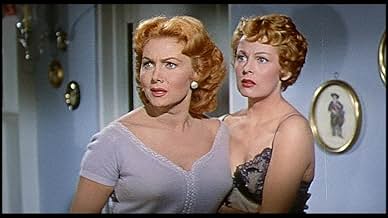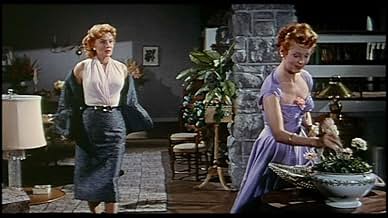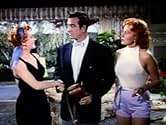IMDb-BEWERTUNG
6,5/10
1373
IHRE BEWERTUNG
Ein städtischer Dealer wird in das organisierte Verbrechen, die korrupte Stadtpolitik und Bestechung verwickelt, während er sich in die Verlobte des neu gewählten Bürgermeisters verliebt.Ein städtischer Dealer wird in das organisierte Verbrechen, die korrupte Stadtpolitik und Bestechung verwickelt, während er sich in die Verlobte des neu gewählten Bürgermeisters verliebt.Ein städtischer Dealer wird in das organisierte Verbrechen, die korrupte Stadtpolitik und Bestechung verwickelt, während er sich in die Verlobte des neu gewählten Bürgermeisters verliebt.
Fred Aldrich
- Policeman
- (Nicht genannt)
Murray Alper
- Hood
- (Nicht genannt)
Albert Cavens
- Man at Campaign Headquarters
- (Nicht genannt)
Ellen Corby
- Martha
- (Nicht genannt)
Paul Cristo
- Man at Campaign Headquarters
- (Nicht genannt)
Sam Flint
- Man at Campaign Headquarters
- (Nicht genannt)
Curt Furberg
- Man at Campaign Headquarters
- (Nicht genannt)
Rudy Germane
- Hood
- (Nicht genannt)
Frank Gerstle
- Dave Dietz
- (Nicht genannt)
Kenneth Gibson
- Man at Campaign Headquarters
- (Nicht genannt)
Roy Gordon
- General Norman B. Marlowe
- (Nicht genannt)
Empfohlene Bewertungen
Any story by James M. Cain should automatically command one's attention. Though probably not as famous as his other stories, this one manages to hold the viewer's interest. A curious thing to me is that, once again, the male lead is playing a far from sympathetic character (Ben). John Payne does a good good job, though sometimes it is not easy to figure out what Ben is up to or why. The success of the film rests upon the performance of the two female leads, Rhonda Fleiming and Arlene Dahl, especially the latter, whose acting was way beyond what I expected and almost carries the film, the ending of which might be a bit surprising. A tad slow in spots, 'Slightly Scarlet' nevertheless is a pretty entertaining film.
I am a trained psychotherapist, so when I watched "Slightly Scarlet", I saw things some others might not see. I mention this because one of the main characters, Dorothy (Arlene Dahl), is a psychological mess. She's a compulsive thief and a girl who craves excitement...all in the worst way. Today, she'd almost certainly be diagnosed with a Borderline Personality...meaning she possesses many qualities of a variety of personality disorders. Antisocial behavior, addictive behaviors and highly volatile mood swings...these are typical of such an individual...and Dorothy is very clearly dealing with these issues.
The film begins with Dorothy being released, yet again, from prison for shoplifting. Her enabling sister, June (Rhonda Fleming), tries her best to help Dorothy but it's clear Dorothy doesn't want saving....she's hell-bent on self destruction, good times and chasing men. Sadly, June is an idiot when it comes to Dorothy and she makes excuses for her wayward sister...and in many ways she enables and encourages Dorothy's actions. How far will all this go? And, how long will June put up with her sister's horrible behaviors? And, how long does Ben (John Payne) fit into all this?
This is a very exciting film that you'll either love or hate. Dorothy's behaviors and June's reactions to them can feel very frustrating....and I could see viewers hating BOTH sisters. But, if you can look past this, the film is fun to watch and worth your time. In some ways, it's like film noir...but the color cinematography make it hard to call it noir. Still, I enjoyed it despite its shortcomings.
The film begins with Dorothy being released, yet again, from prison for shoplifting. Her enabling sister, June (Rhonda Fleming), tries her best to help Dorothy but it's clear Dorothy doesn't want saving....she's hell-bent on self destruction, good times and chasing men. Sadly, June is an idiot when it comes to Dorothy and she makes excuses for her wayward sister...and in many ways she enables and encourages Dorothy's actions. How far will all this go? And, how long will June put up with her sister's horrible behaviors? And, how long does Ben (John Payne) fit into all this?
This is a very exciting film that you'll either love or hate. Dorothy's behaviors and June's reactions to them can feel very frustrating....and I could see viewers hating BOTH sisters. But, if you can look past this, the film is fun to watch and worth your time. In some ways, it's like film noir...but the color cinematography make it hard to call it noir. Still, I enjoyed it despite its shortcomings.
James M. Cain's first Hollywood fusillade went off in the mid-1940s, with Double Indemnity, Mildred Pierce and The Postman Always Rings Twice, all adapted from his books, helping to set the tone and the parameters for the noir cycle just getting up steam. In the mid-50s, he had a second wind, with Serenade and, from Love's Lovely Counterfeit, Allen Dwan's Slightly Scarlet. While not one of Cain's better works or one of the better movies made from them, it has its ample fascinations. Legendary noir director of photography John Alton works in color here, and startlingly enlivens his customary dark trapezoids with bursts of lime green, flame orange and orchid. (The rare films noirs done in color seem even more decadent: see Leave Her to Heaven and Desert Fury). John Payne reprises his solid, sullen self as a fence-straddling minor mobster who sees his chance to take control of the machine in a mid-sized midwestern city. His twin carrot-topped temptations are sisters Rhonda Fleming, as the mayor's gal Friday, and Arlene Dahl, who has just been released from prison -- she's a loony, man-devouring klepto (and Dahl does her proud. There's even a scene when Fleming finds the message "Goodbye Sister" scrawled in lipstick on her bedroom mirror). Too bad there was a lot of (unnecessary) rewriting of Cain's story; the ending is sourly ambiguous. But this is late noir in garish overdrive, and movies aren't much more fun than that.
...with John Payne as an ambitious wheeler dealer working within a crime organization who manages to work his way to the top, while at the same time helping an honest politician running for mayor win that office. He then looks for favors.
Alan Dwan directed and John Alton photographed this production which some have labeled a Technicolor film noir. The cast is a good one. Aside from Payne, the film features Ted De Corsia as the head of the crime organization, Kent Taylor as the newly elected mayor and, in a stunning treat for the eyes, the only screen pairing of two of the most celebrated redheads of '50s films, Rhonda Fleming and Arlene Dahl.
Fleming is the secretary of the future mayor, living in a spacious home about half the size of an average castle and with a maid, to boot (some secretary!), and Dahl plays her sister, just released from prison, with a predilection towards kleptomania and men. Dahl's character is the more interesting of the two and the actress is effective in her role, bringing a flirtatious kittenish irresponsibility to many of her scenes. As the film progresses it becomes apparent that she suffers from a few mental health issues, as well.
But Rhonda - in tight shorts and a torpedo bra - competes with Dahl in her own special way, and I don't mean shorthand skills. Payne, perhaps a little overshadowed by the screen activity of the two lovely redheads, is still a credible tough guy, the film predictably leading up to his final confrontation with De Corsia and his mob.
Aside from the noteworthy contributions of Dahl and Fleming, Slightly Scarlet, based upon a novel by James M. Cain, may draw a bit of a surprise for some by the ambiguity of its ending.
Alan Dwan directed and John Alton photographed this production which some have labeled a Technicolor film noir. The cast is a good one. Aside from Payne, the film features Ted De Corsia as the head of the crime organization, Kent Taylor as the newly elected mayor and, in a stunning treat for the eyes, the only screen pairing of two of the most celebrated redheads of '50s films, Rhonda Fleming and Arlene Dahl.
Fleming is the secretary of the future mayor, living in a spacious home about half the size of an average castle and with a maid, to boot (some secretary!), and Dahl plays her sister, just released from prison, with a predilection towards kleptomania and men. Dahl's character is the more interesting of the two and the actress is effective in her role, bringing a flirtatious kittenish irresponsibility to many of her scenes. As the film progresses it becomes apparent that she suffers from a few mental health issues, as well.
But Rhonda - in tight shorts and a torpedo bra - competes with Dahl in her own special way, and I don't mean shorthand skills. Payne, perhaps a little overshadowed by the screen activity of the two lovely redheads, is still a credible tough guy, the film predictably leading up to his final confrontation with De Corsia and his mob.
Aside from the noteworthy contributions of Dahl and Fleming, Slightly Scarlet, based upon a novel by James M. Cain, may draw a bit of a surprise for some by the ambiguity of its ending.
"You're not good; you're not bad. You're a chiseler, out for anything you can get."
So, says Solly Kaspar, crime boss of Bay City, of Ben Grace, the anti-hero of this story, adapted from James M. Cain's Love's Lovely Counterfeit. What holds our interest in this story is we're never quite sure what to make of Grace.
There's an upcoming election and crime boss Kasper does not want the reform candidate to win, so Kasper strongarms the newspaper publisher backing him, and in the process kills him.
Grace exposes Kasper, forcing Solly to flee to Mexico, and insuring the election of Frank Jansen, the reform candidate. He uses his influence with Jansen to get an honest police lieutenant friend of his appointed Chief of Police.
Good guy, right?
Then later in this movie he's seen giving orders to Solly's men, going over Solly's books, and positioning himself as Solly's successor. He calls his friend,the chief of police, and demands that his girlfriend's sister who was recently arrested be released without being charged, and so we begin to believe we've misjudged ol' Ben. He's just a hood, a little brighter than most, a little smoother than most, but in the end, no different from Solly Kasper.
Bad guy, right?
Well, we're not sure, because Grace isn't sure. Reform mayoral candidate, soon to be mayor, Frank Jansen has an assistant, June Lyons. On a 1 to 10 scale, Ms. Lyons, with her flaming red hair, and blazing headlights (think Good Girl art) is an 11. Rhonda Fleming never looked better, and Arlene Dahl as her sister, Dorothy Lyons, was equally stunning. But, back to Grace. He is falling for June, and June is a thoroughly decent girl, whose better nature seems to affect him.
In the end, however, Grace's schemes come to naught. Jansen who really is a reform candidate orders Dorothy be tried for her crimes. Solly Kasper returns wanting to take over as rackets boss, and Ben Grace is forced to run. Here's where we see his true character, when he scrounges as much of Solly's money as he can and invites his girlfriend to go on the run with him (she declines).
Solly Kasper was right all along. He really is just a chiseler, out for whatever he can get. Major disappointment, as in the end, Ben Grace disappoints not just his girlfriend, but the audience as well.
This is a beautifully photographed movie in full technicolor. The sets are a wonderful amalgam of art deco - rococo excess. Others here have pointed out how garish everything looked. I didn't find it so. I thought it was beautiful. Certainly, the eye candy was stunning. There aren't any two actresses today who could team as good girl - bad girl siblings the way Fleming and Dahl did. Maybe Julianne Moore and Debra Messing, but they wouldn't look as good. The movie's high marks for visual style are undermined by its low marks for aimless, meandering story. 6 out of 10.
So, says Solly Kaspar, crime boss of Bay City, of Ben Grace, the anti-hero of this story, adapted from James M. Cain's Love's Lovely Counterfeit. What holds our interest in this story is we're never quite sure what to make of Grace.
There's an upcoming election and crime boss Kasper does not want the reform candidate to win, so Kasper strongarms the newspaper publisher backing him, and in the process kills him.
Grace exposes Kasper, forcing Solly to flee to Mexico, and insuring the election of Frank Jansen, the reform candidate. He uses his influence with Jansen to get an honest police lieutenant friend of his appointed Chief of Police.
Good guy, right?
Then later in this movie he's seen giving orders to Solly's men, going over Solly's books, and positioning himself as Solly's successor. He calls his friend,the chief of police, and demands that his girlfriend's sister who was recently arrested be released without being charged, and so we begin to believe we've misjudged ol' Ben. He's just a hood, a little brighter than most, a little smoother than most, but in the end, no different from Solly Kasper.
Bad guy, right?
Well, we're not sure, because Grace isn't sure. Reform mayoral candidate, soon to be mayor, Frank Jansen has an assistant, June Lyons. On a 1 to 10 scale, Ms. Lyons, with her flaming red hair, and blazing headlights (think Good Girl art) is an 11. Rhonda Fleming never looked better, and Arlene Dahl as her sister, Dorothy Lyons, was equally stunning. But, back to Grace. He is falling for June, and June is a thoroughly decent girl, whose better nature seems to affect him.
In the end, however, Grace's schemes come to naught. Jansen who really is a reform candidate orders Dorothy be tried for her crimes. Solly Kasper returns wanting to take over as rackets boss, and Ben Grace is forced to run. Here's where we see his true character, when he scrounges as much of Solly's money as he can and invites his girlfriend to go on the run with him (she declines).
Solly Kasper was right all along. He really is just a chiseler, out for whatever he can get. Major disappointment, as in the end, Ben Grace disappoints not just his girlfriend, but the audience as well.
This is a beautifully photographed movie in full technicolor. The sets are a wonderful amalgam of art deco - rococo excess. Others here have pointed out how garish everything looked. I didn't find it so. I thought it was beautiful. Certainly, the eye candy was stunning. There aren't any two actresses today who could team as good girl - bad girl siblings the way Fleming and Dahl did. Maybe Julianne Moore and Debra Messing, but they wouldn't look as good. The movie's high marks for visual style are undermined by its low marks for aimless, meandering story. 6 out of 10.
Wusstest du schon
- WissenswertesArlene Dahl offered to play cards with Rhonda Fleming to determine who would be the first on the poster. Dahl won the game, and in return demanded that Fleming be the first in the credits of the film. Fleming was very touched by this gesture and the two actresses became good friends.
- PatzerVery early in the film, just after Dorothy Lyons has been released from prison, Ben Grace is in police Lt. Dietz's office discussing her. The lieutenant is perusing Miss Lyons' criminal file which the viewer can briefly view. At the top of the document a spelling error displays her name as "Dorthy Lyons".
- Zitate
Solly Caspar: Let's see if we can beat him down.
[after throwing a body out of an upper story window]
- VerbindungenFeatured in Saving Cain: Robert Blees on 'Slightly Scarlet' (2009)
- SoundtracksFor He's A Jolly Good Fellow
(uncredited)
Traditional
Heard at the announcement of the election results
Top-Auswahl
Melde dich zum Bewerten an und greife auf die Watchlist für personalisierte Empfehlungen zu.
- How long is Slightly Scarlet?Powered by Alexa
Details
- Erscheinungsdatum
- Herkunftsland
- Offizielle Standorte
- Sprache
- Auch bekannt als
- Slightly Scarlet
- Drehorte
- Produktionsfirmen
- Weitere beteiligte Unternehmen bei IMDbPro anzeigen
- Laufzeit
- 1 Std. 39 Min.(99 min)
- Seitenverhältnis
- 2.00 : 1
Zu dieser Seite beitragen
Bearbeitung vorschlagen oder fehlenden Inhalt hinzufügen



